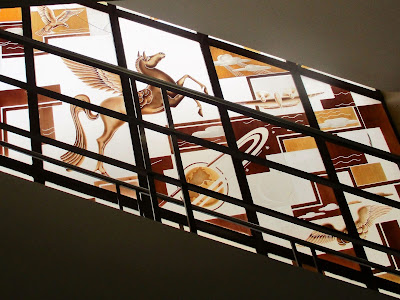Here's Aeolus at Airbus in my home town of Filton.
Except we were there mainly to visit a building that is an icon of the aircraft industry in these parts, but which I'd never been inside.
This is how New Filton House looked back when the whole world was in black and white. I remember getting excited whenever it was on the national news, as a backdrop to a report about Concorde, which was made here and in Toulouse.
In 1992, it was vacated by British Aerospace and fell into disrepair. I took my son to photograph the exterior for a project when he was at the local primary school.
I was far from the only outraged Filtoner. One group of locals actually did something practical and put in application for listed building status, which was successful in 1999.
Eventually Airbus, who by then owned the place, covered it in scaffolding and plastic. Here it is in 2008.
Built in 1932, New Filton House (or Pegasus House, as it's called these days) was built to house the Bristol Aeroplane Company, which everyone in Filton called the BAC, and thereafter the British Aircraft Corporation, which handily had the same initials.
And this is Old Filton House, which dates from the 18th century and was the previous company headquarters. It too was left to lapse into dereliction before being restored ...
... here with the new Airbus building looming behind. Which is a bit of a shame as from some angles the latter does New Filton House's job of dominating the skyline, only rather less elegantly.
I was happily lapping up familiar sights from new slants. Here's the simple but pleasing Garden of Remembrance ...
... and look, the tree that's lit up every Christmas from the other side!
New Filton House was commissioned by Sir Stanley White, son of Sir George, the father of British aviation and founder of the British and Colonial Aeroplane Company (its original incarnation).
We were being ushered through the main entrance, which the workers weren't permitted to use back then. I felt a bit of a scab ...
... but it did give us a chance to inspect the first of several sculptures on site by Denis Dunlop, in this instance, Mercury.
The first beautiful thing you encounter inside is Dunlop's coloured terrazzo floor which features the signs of the zodiac, the winds and the sun.
... and the way it interacts with the amazing staircase.
We were then taken to the conference room which has moulded plaster panels running down either side of the window with various depictions of flight, these also by Denis Dunlop.
 Icarus and Daedalus
Icarus and DaedalusAt this point all of us who were taking photos like mad were told that we shouldn't be really, which was a bit of a shame as I didn't see any top secret blueprints for stealth bombers lying around on desks. But I did stop. (Sort of.)
The Gloucester Road from an unwonted angle
The exterior of Juta's stained glass window
The lift
This is the safe in the strong room in the basement where the wage packets for thousands of workers were put up every week.
Just time for a final look at two very familiar sculptures by Dunlop: the 1935 Bristol Type 143 aeroplane 'Britain First' (no relation to the fascist hate group of the same name) ...
 ... and beneath it, Pegasus, representing the aero engine made here.
... and beneath it, Pegasus, representing the aero engine made here. So pleased, finally, to have experienced the fabulous art of my home town.































Lovely - I had no idea - must try and visit myself
ReplyDeleteMe neither and I'm a native.
Delete